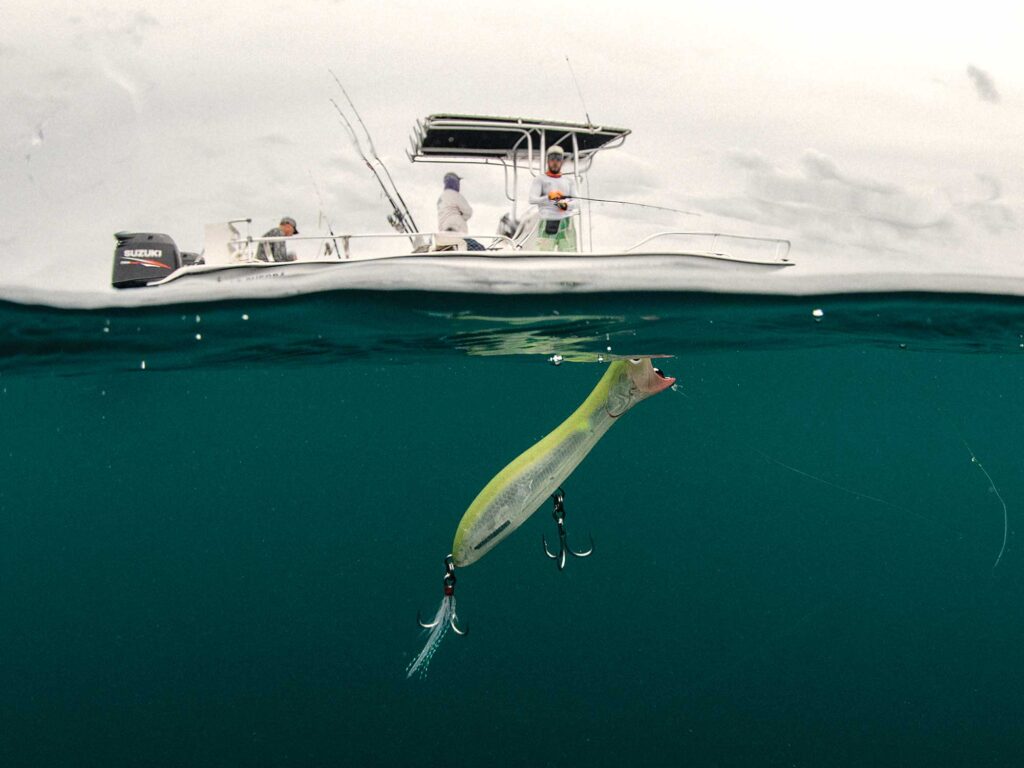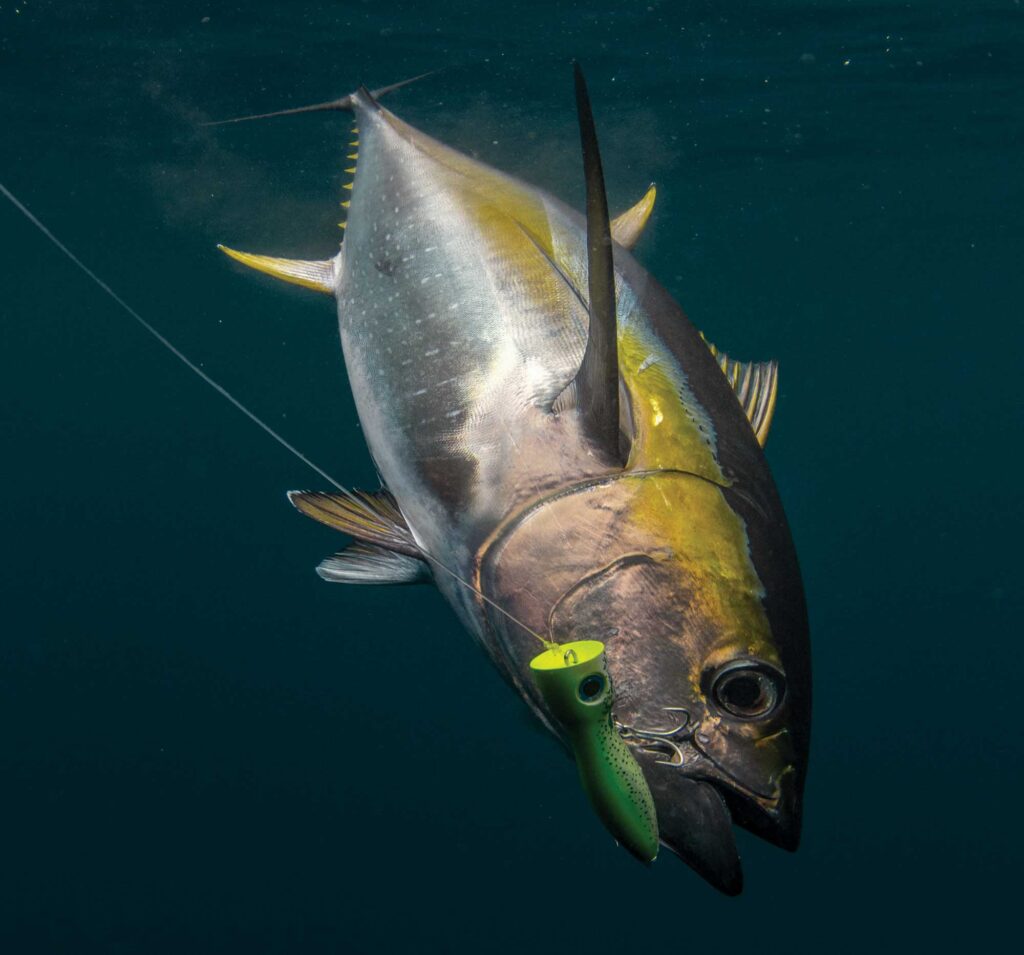
Much of fishing takes place below the water’s surface, hidden from view. So the allure of topwaters is evident, as you add sight to the equation. No matter how many times I see it, watching a monster rocket from the brine and smash my plug before disappearing below in a drag-peeling run kicks up my heartbeat.
Besides being a thrilling way to fish, there are advantages to throwing topwaters such as poppers, sliders and walk-the-dog-style baits. Ripping a swimming plug through a grassbed is a surefire way to get hung up, or at least have the hooks fouled, but a surface plug can zip along the tops of the grass and still get bit. And no one likes donating fresh bunker to dogfish, but that happens with great regularity. You can avoid the bait thieves by working the periphery of the bunker pods with oversize poppers. It’s more fun anyway.
Want more topwater action? Follow these tips to catch more inshore and offshore favorites.
Hit the Creeks for Topwater Action
Salt marshes are productive areas, and one of the most exciting—and effective—ways to fish them is with topwater plugs. If you want to tangle with striped bass, redfish or snook, head to your nearest marsh two hours before high tide. Let the rising water push your boat back into the deepest sections, invading the areas where baitfish hide until the water gets high enough to let in gamefish—and anglers.
Once in position, key in on any visible structure. Pound mouths of the feeder creeks that dump into the wider channels; these will be depositing hapless baitfish as the water recedes. Follow the water as it drains, concentrating on the deeper holes and cuts on the way out. There often will be a window where predators seemingly lose all caution. They’ll hit just about anything forced down the buffet line.
Because these areas are so shallow, you’d be hard-pressed to work anything other than a topwater effectively. I tend to opt for the subtler action of a walk-the-dog-style plug in these calm environments, working them fairly slowly to gently coax strikes. I like floating MirrOlures like the Top Dog and Berkley’s J-Walkers. But when subtle doesn’t cut it, such as when the wind puts some significant ripples on top, go for a popper like Yo-Zuri’s 3D Inshore Popper.

Tuna on Top
Based out of Rhode Island, Shimano pro-staffer Capt. Max Dispoto runs inshore and offshore trips for East Coast Charters. He has spent a significant portion of his life targeting large gamefish such as bluefin and yellowfin tuna on casting gear in the waters off New England and down to New Jersey. But he wanted even more excitement, so over the years, he refined gear, tactics and techniques to successfully target and land these fish in the most exhilarating way possible: throwing topwaters. If you want to get into tuna on top, Dispoto recommends that you look for the following scenarios.
“The best scenario is when fish are actively feeding on the surface and you’re able to see them coming out of the water,” Dispoto says. “It’s easier to get a fish to commit to a popper when this is happening because it is obvious where they are. Although you can see them, cast placement still has to be near-perfect. If the fish are on the move, cast to where they will be, not to where they were. Remember, these fish move fast. You have to keep your bait in front of them.”
Though it might be tougher to get bluefins to eat a popper when they aren’t visible on top, it’s not impossible. Instead, Dispoto says you must look for other clues.
“To get into a topwater bite when they aren’t showing on the surface, concentrate on working your popper near other life. This means blind-casting around whales, dolphins or birds; hopefully, it’s all three, but it could be just one. To be successful, it’s important to stay consistent with good casts and not give up right away. It might take time to figure out where the fish are; some days they stay right next to the whales, some days they are on the edge of all of the commotion and there are just some piles of birds that will tip them off. Eventually, the popper will entice a fish to come up and hit the popper.”

Staying calm is another key to success, Dispoto says. “You need to control your adrenaline and pay attention to how you are working the popper, which can be really difficult when big fish are breaking the surface. Ripping the popper too aggressively and skipping it out of the water will look unrealistic to the fish, and they will not eat. Slow, long sweeps with a short pause in between consistently produce the most bites.”
Dispoto only uses heavy-duty through-wired models. He likes makes with well-designed cups that create splashy bubble trails to catch a tuna’s attention, such as Shimano’s Bomb Dip (170 mm) or Madd Mantis’ 6.5- or 8-inch poppers. He prefers trebles, opting for the Owner ST-66 in either 2/0 or 3/0, depending on the size of lure.
Dispoto likes rods around 7.5 feet, choosing models that offer a combo of casting distance, lifting power, and comfort through a long fight. Rod selection depends on the size of fish he thinks he’ll encounter, such as a 7-foot-7-inch MH Shimano Grappler Type C for sub-150-pound fish, or a 7-foot-10-inch XH Shimano Ocea Plugger Big Game for bluefins up to 80 inches.
He matches these to 14000- or 18000-size reels with high gear ratios to pick up line and restart casts as quickly as possible, such as models in Shimano’s Saragosa, Twin Power and Stella lines. Make sure they hold a minimum of 300 yards of braid; use 65-pound-test PowerPro on 14000-size reels and 80-pound on larger. Dispoto connects his braid to a 10-foot shot of Seaguar Blue Label 80-pound-test fluorocarbon leader with an FG knot. To connect leader to lure, he uses a Palomar knot tied to a 200- or 300-pound swivel with a matching split ring connected to the lure.
Baitcasters: The End of Wind Knots?
Working poppers with violent twitches of the rod tip is a great way to entice strikes, but the slack line often results in a loop on the spool that quickly turns into a knot. Using a baitcaster significantly reduces the potential for tangles because the revolving spool won’t trap loops like a spinning reel will. I grew up with Abu Garcia Ambassadeurs, but recent offerings such as Penn’s Fathom and Shimano’s Tranx have given anglers purpose-built low-profile offerings.

Steer a Spook
“Hands-down my favorite way to fish for striped bass is with big topwater lures,” says Salt Water Sportsman Editor-in-Chief Nate Matthews. “While it’s always a blast to watch a cow annihilate a pencil popper, for my money you can’t beat the action and versatility of a giant, walk-the-dog bait.”
Matthews says there are a couple of things that make these baits so useful. One of them is their profile. Big bass like big baits. Little ones do too. If you fish somewhere adult bunker are common, you can’t go wrong with a 9-inch Doc. Lob out the big plug and it’ll smack the water with enough commotion to alert every fish in the area. Thrash it like a pencil popper and aggressive bass will come running. But these lures shine when you fish them with finesse.
“The key to working Docs (and other big dog walkers) is using sharp sweeps of the rod followed by pauses that leave some slack in your line,” Matthews explains. “Your bait will dart to the side, then glide slowly across the surface until the slack comes tight. Sweep again and it’ll dart back the other way. The bigger the bait, the longer the glide. It’s a great way to present a lifelike target that stays in the strike zone for a long time.”
“Stripers as a rule like to play with their food and will swirl on your plug, smack it with their tails, and bump it with their noses. I’ve watched big bass follow my Docs all the way from the end of a cast to the tip of the rod before deciding to commit,” says Matthews, noting that the real challenge comes when a bass starts following your lure. “It’s a heart-stopping way to fish and one that requires a lot of composure to avoid jerking your lure out of the strike zone before the actual eat.”
Matthews’ ace in the hole is a trick he uses to steer a big spook around structure. He says the key is in how long you pause between each sweep of your rod. If you consistently pause longer when the bait glides left and shorter when the bait glides right, you’ll steer your bait to “swim” to the left. Reverse your cadence and you’ll steer it to the right. “It’s a helpful trick to know when you want to keep your plug up tight to a dock, or even to glide underneath one to reach places you wouldn’t otherwise be able to cast.”
Cheat Code: Popping Corks
“Today’s popping-cork rigs get a bad rap,” says Salt Water Sportsman senior editor Sam Hudson. But why? “In a few words, the presentation is too reliable at catching species such as red drum and spotted seatrout. Some anglers actually believe it’s too easy. But I say, don’t turn up your nose at popping corks; instead, add them to your arsenal.”
Hudson wants to set the record straight: “Popping corks are versatile and indispensable. Most styles—and there are plenty from local, regional and national makers—incorporate a floating cork that moves up and down a metal (or mono) through-wire, bouncing against beads above and below the cork. A light weight also might be included to keep the cork vertically positioned when at rest. Corks with a through-wire have a pair of swivels to use as connection points for your leader and main line. A second popular option, the inline cork, attaches to your existing ‘tight line’ soft-plastic rig. There are no swivels—you can attach and detach the basic cork at whatever length along your leader.
“The magic sauce is how the angler works the popping cork,” Hudson continues. “This isn’t a bobber-and-worm presentation. There’s definite skill involved, even though new anglers can have immediate success with some helpful coaching. Retrieve the popping cork to create a clacking noise; after a pop of the rod, stop and wait to let the soft-plastic shrimp or jig fall naturally. Anglers believe that the presentation and attractive sound mimic a fleeing baitfish or baitfish in distress.”
Rig your cork at least the same distance from the lure as the depth you’re fishing to allow the lure to reach the bottom. Once you fish waters deeper than about 4 feet, popping corks lose their mojo. They even become hard to cast out. Something like a slip float might be a better option. Or just no float or cork at all.
“So when you really want that topwater bite to happen and it just isn’t, break out the popping cork,” Hudson says. “Or if you’re having trouble locating trout or reds in a creek or on a flat, call them in with a clack and a pop.”
Read Next: Capt. John McMurray’s Top Topwater Lures for Tuna

When to Pop and When to Walk
A graduate of Texas A&M University at Kingsville with a Bachelor of Science degree in Range and Wildlife Science, Capt. Brian Barrera takes to the waters of south Texas with a scientific eye and unique understanding of the gamefish that prowl the shallows. He takes a measured approach to selecting topwaters, opting for poppers or sliders depending on the scenario.
“I prefer a popper when fishing deeper areas because I tend to get a better hookup ratio from it not moving as quickly,” Barrera says. “In extreme shallow water, I prefer a walk-the-dog-style bait because the fish tend to follow it from close behind rather than coming up from completely underneath. I also like to change up my retrieve based on the conditions I am fishing. The windier and louder it gets outside, the louder and more ferociously I am popping that popper or walking that dog.”
Because of the shallow, clear waters he fishes along Laguna Madre, Barrera opts for heavy plugs for the added distance and stealth that long casts provide. As far as walk-the-dog-style baits go, he likes the Shimano Current Sniper Twitchbait 80 Hi-Pitch and the classic Heddon Spook Jr. He will turn to the DOA Lures PT-7 when it gets weedy because the soft-plastic bait tends to stay free of grass. For poppers, he has been throwing Shimano Pop-Orcas almost exclusively for big redfish, snook and other inshore species.
Reverse Pencils
Pencil poppers—said to be the brainchild of lure designer extraordinaire Stan Gibbs, who crafted the wooden surface plugs with a narrow top and more rotund bottom to imitate a baitfish trying to skedaddle out of trouble—are very productive when fished in the traditional manner with sharp pumps of the rod.
But reversing them provides a distinct look that can draw bites when nothing else will, with a floundering, diving action. To try this yourself, select a through-wired wooden pencil, such as the ones still made by Gibbs, and remove the hook from the rear of the plug. Place a hook on what was the head, and fish it in much the same manner as before.
The new dynamics will give the plug a new look, diving headfirst when motion ceases. Try it when squid follow the sand eels; it can be absolutely deadly.









